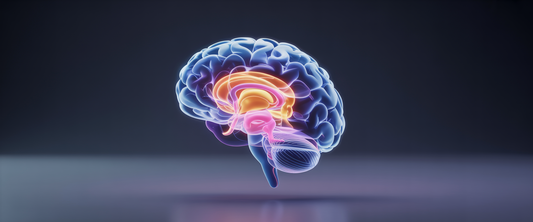According to a new study, creative activities slow brain aging

TL;DR
A groundbreaking international study involving over 1,400 participants has proven that creative activities—from tango dancing to strategic video games—can measurably slow brain aging and protect against cognitive decline. The research shows that engaging in creative pursuits acts like exercise for your brain, with benefits comparable to diet and physical fitness in maintaining cognitive health as you age.
Why This Matters
This research fundamentally changes how we approach brain health optimization. Instead of waiting for cognitive decline or relying solely on supplements and diet, you now have scientific proof that creative engagement can actively protect your brain's most vulnerable regions. For wellness-focused individuals, this means creativity isn't just a hobby—it's a powerful, accessible tool for maintaining peak cognitive performance and building resilience against age-related mental decline. The study's findings suggest that incorporating creative activities into your routine could be as important as your workout schedule or nutrition plan for long-term brain health.
Key Facts
- Massive scale: Researchers across 13 countries analyzed brain data from more than 1,400 participants, including creative experts and beginners
- Measurable protection: Creative engagement consistently showed "younger" brain patterns in regions most vulnerable to neurodegeneration
- Quick benefits: Even short-term creative training produced measurable improvements in brain health markers
- Universal access: Benefits occurred regardless of expertise level—beginners gained from brief video game training sessions
- Comparable impact: Effects were similar in magnitude to established brain health interventions like exercise and proper nutrition
- Diverse activities: Benefits seen across tango dancing, music, visual arts, strategic gaming, and other creative pursuits
What the Science Shows
The research team used sophisticated "brain clock" models to measure how creative engagement affects brain aging. These models compare your brain's biological age to your chronological age, revealing whether your brain is aging faster or slower than expected.
"Our results open new avenues for creativity-based interventions to protect the brain against ageing and disease," said Dr. Agustin Ibanez, senior author and professor of brain health at Trinity College Dublin's Global Brain Health Institute. "The impact of creativity on the brain was comparable to exercise or diet."
The study's first author, Dr. Carlos Coronel, emphasized the accessibility of these benefits: "You do not need to be an expert to benefit from creativity. We found that learners gained from brief video game training sessions. While these creative experiences differ, they share a common thread: they help protect brain connections that are vulnerable to accelerated ageing."
In Plain English
Think of your brain like a complex city with millions of interconnected highways (neural pathways). As we age, some of these highways naturally start to deteriorate, especially in areas responsible for memory, decision-making, and learning. Scientists can now measure this deterioration using "brain clock" technology—essentially comparing how old your brain looks on scans versus your actual age.
What this study discovered is that creative activities act like a maintenance crew for your brain's highway system. When you engage in creative pursuits, you're actively strengthening and protecting the neural connections that are most at risk of age-related damage. The more consistently you engage in creative activities, the better maintained your brain's infrastructure remains over time.
The Wellness Angle
This research reveals four critical insights for optimizing cognitive performance and longevity:
1. Creativity as Preventive Medicine: Rather than treating cognitive decline after it occurs, creative engagement offers a proactive approach to brain health. The study suggests creativity could be prescribed like exercise—a low-cost, accessible intervention that anyone can implement regardless of age or current cognitive status.
2. Neuroplasticity in Action: Creative activities stimulate neuroplasticity—your brain's ability to form new connections and adapt throughout life. This explains why diverse creative pursuits all showed similar benefits: they challenge your brain to think in new ways, strengthening cognitive flexibility and resilience.
3. Stress and Recovery Benefits: Creative engagement often involves flow states that reduce cortisol and promote relaxation while simultaneously challenging cognitive function. This unique combination may explain why creative activities are particularly effective for brain health compared to passive entertainment.
4. Social and Emotional Integration: Many creative activities involve social interaction (like tango dancing) or emotional expression (like visual arts), which research shows are crucial for maintaining cognitive health and preventing isolation-related decline.
What You Can Do
Start where you are: Choose creative activities that genuinely interest you. The research shows benefits across diverse pursuits, so follow your natural inclinations rather than forcing activities you don't enjoy.
Commit to consistency: While even short-term engagement showed benefits, sustained creative practice produced the most significant brain protection. Aim for regular creative engagement rather than sporadic intensive sessions.
Challenge yourself progressively: Whether learning a musical instrument, trying strategic games, or exploring visual arts, gradually increase complexity to continue stimulating neuroplasticity.
Combine with existing wellness practices: Integrate creative activities with your current health routine. Consider creative movement like dance as both physical exercise and brain training, or use music during meditation or workout sessions.
Track cognitive benefits: Monitor improvements in focus, memory, problem-solving, and mental flexibility as you maintain creative practices over time.
What to Watch
Clinical applications: Expect to see creativity-based interventions integrated into cognitive rehabilitation programs and preventive healthcare protocols as this research influences medical practice.
Workplace wellness: Companies may begin incorporating creative activities into employee wellness programs as understanding grows about creativity's impact on cognitive performance and stress management.
Personalized approaches: Future research will likely identify which types of creative activities are most beneficial for different individuals based on genetics, lifestyle, and cognitive goals.
Technology integration: Development of apps and digital platforms designed to deliver scientifically-backed creative brain training that combines entertainment with measurable cognitive benefits.
Bottom Line
Creative engagement isn't just enjoyable—it's a scientifically-proven strategy for maintaining cognitive health and slowing brain aging. Whether through music, dance, visual arts, or strategic gaming, regular creative practice can protect your brain's most vulnerable regions while enhancing mental performance. The best part? You don't need expertise to benefit, making creativity one of the most accessible and enjoyable approaches to long-term brain health optimization.



